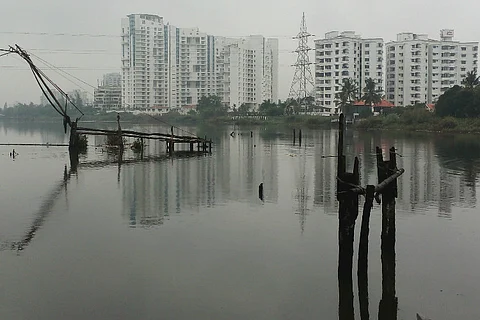

Thirty-seven-year-old Gopi pays a “huge” sum as rent for a tiny house on Vypeen island in coastal Kerala’s Ernakulam district. “I have to pay even though I own our family’s ancestral property,” he says.
Some parts of Vypeen island falls under the Coastal Regulation Zone, which regulates building activity along the coast and certain water bodies. But Kochi’s fishing community has alleged that these rules are being applied selectively.
“Flats built near Gosri bridge cover a large part of Kochi lake and Periyar river. These buildings are practically on the water. A perfect breach of law. But I cannot build a house in Nayarambalam, on my own ancestral property,” Gopi alleges.
Another fisherman from the area, 42-year-old Madhu, faces a similar problem. “We see huge high rises mushrooming on the banks of Kochi’s lakes, but we have to spend months in Thiruvananthapuram for sanction to build two-room huts near our ancestral homes. Most of the time, our applications are rejected.” Madhu says.
In 2015, a group of fishermen sought information under RTI about CRZ violations in Kochi. In its reply, the government said that two resorts, and 750 houses belonging to those of the fishing community in Ernakulam had been built in violation of CRZ rules. Classified as violators of CRZ Rules, these houses do not have door numbers which are necessary for obtaining power supply, water connection, ration card etc, from the government.
Activists however, allege that many glaring violations have been left out of the net.
Fishermen meeting in Vypeen fish market
“There are huge flats, hospitals, resorts, hotels etc… in Kochi city which have clearly breached the rules and we gave a detailed report to the Supreme Court in 2014. But nothing came of it,” VN Babu Vembanadu, convenor of the Lake Protection Council, told TNM.
Many high rises and apartment complexes built after 2004 in Edakochi, Chilavannur, Thoppumpadi, Cheranellur, Mulavukad and Marine Drive have been left out, they allege.
The Coastal Regulatory Zone (CRZ) Rules were first passed in 1991 to protect coastal areas and water bodies, but have been amended 25 since. Enforcement of the rules was made strict after 2005 following a Supreme Court order. Currently, the CRZ Rules 2011 are in force.
Fishing communities across the country including in Kerala have protested against the Rules, alleging that their access to the sea – a commons – was cut off, and did not allow them to build houses or even carry out renovations.
Against this backdrop, the MS Swaminathan committee was tasked with re-assessing the amendments to the CRZ rules in 2004. A second committee was appointed in 2008. In February 2010, the then environment minister Jairam Ramesh assured activists and the fishing community that all loopholes would be plugged and that the new CRZ rules would be fishing community-friendly.
“We fought for many years, held protests and hunger strikes until February 8, 2010. Jairam Ramesh had assured that he would protect the traditional rights of the fishing community. But later, we realised that all promises were false,” says Charles George, an environment activist and advocate who was one of the leaders of the protests.
After all this, the 2011 Rules ended up making the situation even worse for the fishing community, Charles says.
“The average population density in Kerala’s coastal areas is around 2,200 when the state’s is 810. The coastal areas need protection, but fishing communities are indigenous, and they too need protection.”